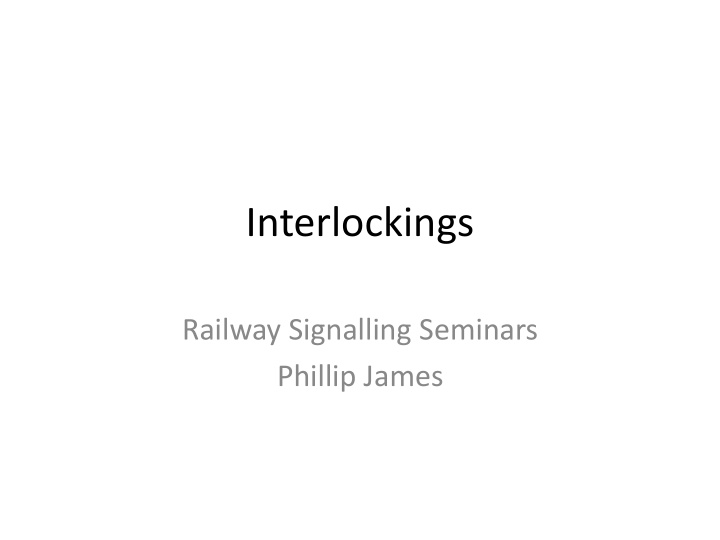



Interlockings Railway Signalling Seminars Phillip James
Overview • All about Interlockings. • What, why, when, how, (who? – any guesses). • Techniques involved. • Solid State Interlocking.
The Basics (Or at least that’s what Invensys would say )
The Interlocking
A Giant Jigsaw • Ensures Safety: – Conflicting routes not set. – Points only move if safe to. – Signals clear when given conditions are met. • Must also be fail safe.
Route Setting Process 1. Signaller selects entrance/exit points. 2. Interlocking checks route availability. 3. If available interlocking locks route. 4. Released cancelled when train passes. 5. Consecutive track circuits along route released. (next track released only if previous is.) 6. Signaller informed of track circuit release. Throughout -- interlocking sets required signals.
A Picture ( anyone think of a better title? )
The Route Setting Panel
Route Availability and Signals (I wonder if there is an available route to the end on my PhD?!?!)
Conflicting Routes Routes that share a point conflict. Here 15 and 17 are conflicting (201 shared).
Opposing Routes Routes which require opposite directions of travel are know as opposing. Here 37-39 and 38-36 are opposing.
Signal Setting Signals are set relative to a set of given rules. Signal 17 can clear when: *can also include time (approach control)
Overlaps Condition for 17 to clear may include SE clear.
Control Tables (Where all the logic is.)
Example Control Table Material removed due to sensitive nature...
Solid State Interlockings (The engineers realise computers may help...)
The SSI • Microprocessor based interlocking developed in late 1970’s. • First one installed 1985 (Lemmington Spa). • Invensys (or Westinghouse) involved in production. • Design consists of several electronic “modules”.
The Multiprocessor Module • Main module for computation. • Implements a 2 out 3 voting system. • Many other modules for trackside communication, memory, signaller interfaces etc
Ladder Logic • The Westrace interlocking designed by Invensys is programmed using ladder logic. • Basically a series of Boolean equations. • Similar to relay logic. • “Encodes” control table logic.
Execution of Ladder Logic Classic control loop (like a while statement)
Ladder Logic -- Basic Constructs
Example Program: Ladder Logic What equations does this program encode?
Summary • The job of the interlocking. • Concepts involved in route locking. • Signal setting. • Solid State interlockings. • Ladder Logic. Next: train describers, remote control systems and level crossings
More recommend